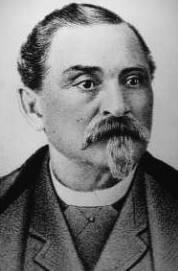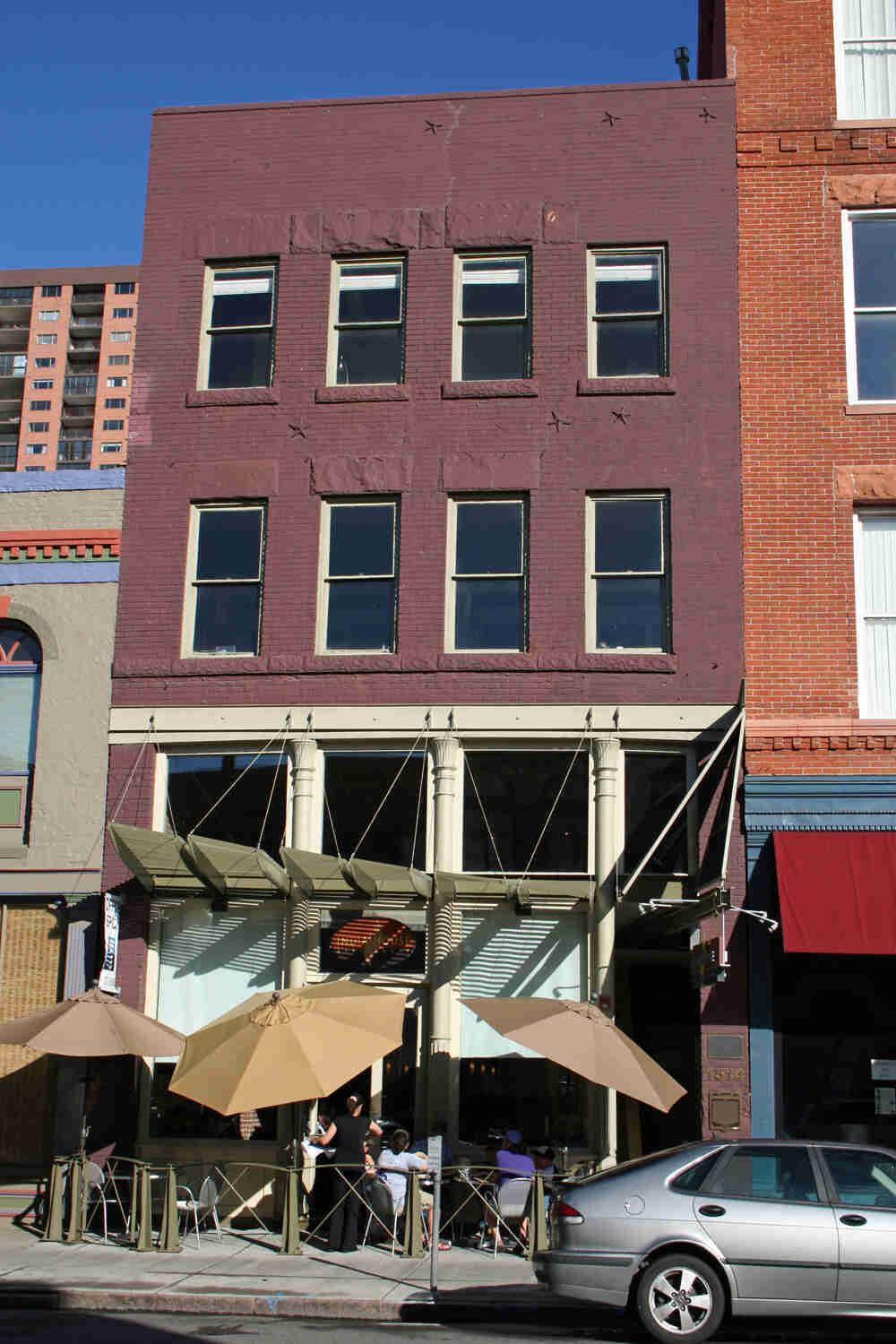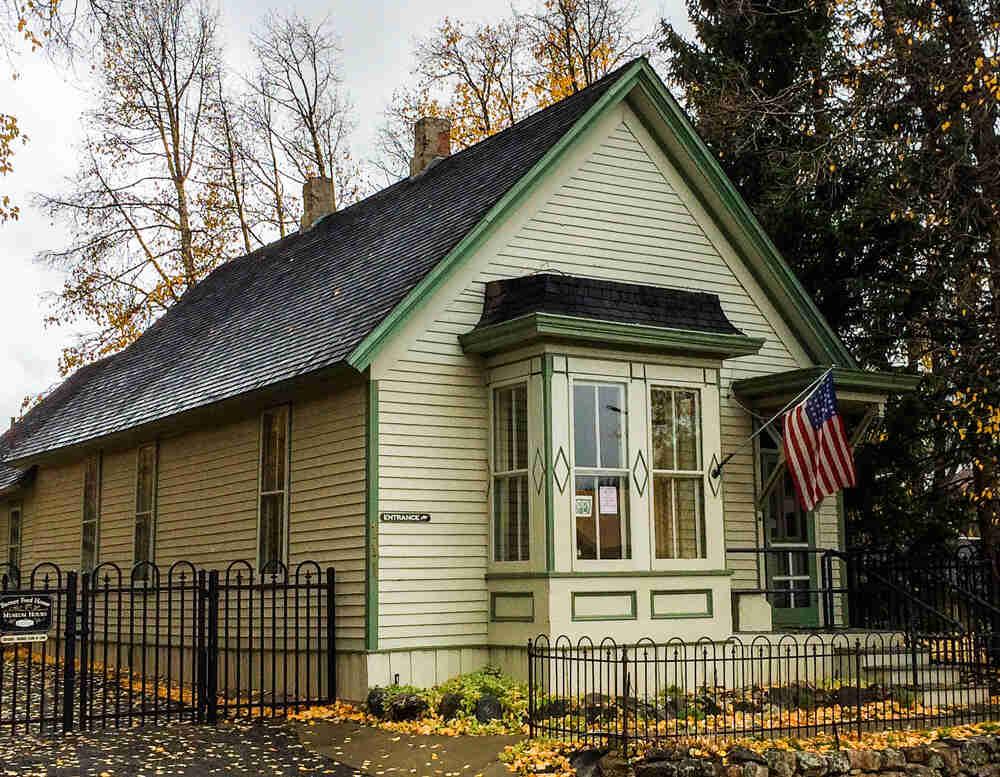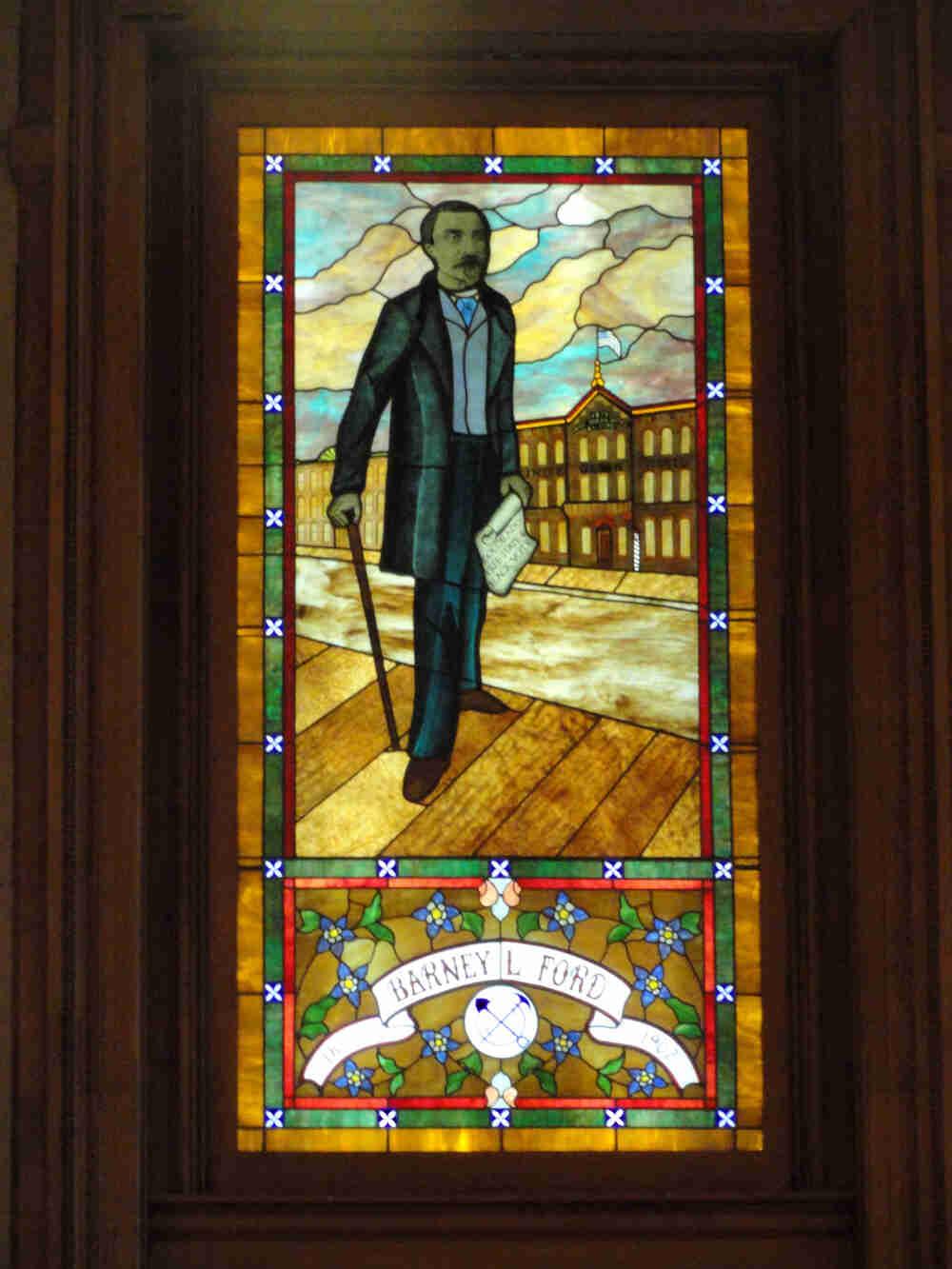Barney Ford
Full Article
Born into slavery in 1822, Barney Ford escaped to freedom and moved to Colorado in 1860. He soon became a successful businessman and an influential civic leader who pushed for Colorado statehood with suffrage for all. Ford died in Denver in 1902 and has been recognized for his contributions to the state with a stained-glass window in the State Capitol.
Escape from Slavery
The child of an enslaved mother and a white father, Barney Ford was born on January 22, 1822, in Stafford, Virginia. In childhood he was enslaved in South Carolina. At age 26, he escaped to Chicago. There he became a barber and made friends in abolitionist circles. He also met his wife, Julia Lyoni.
In 1851 Ford and his wife left Chicago to try their luck in the California Gold Rush. Traveling by ship, they passed through the port of Greytown, Nicaragua, and decided to settle there instead of continuing to California. Ford opened a hotel that catered to Americans and soon rose to prosperity. In 1854, however, he suddenly lost his hotel when an American ship bombarded the town because of a dispute about the rights of American citizens there. After their hotel was destroyed, Ford became a steward on Lake Nicaragua, then opened another hotel. The American General William Walker arrived in Nicaragua in 1855. He took control of the country with the goal of recolonizing it. Ford returned to Chicago, where he operated a livery business that may have doubled as a station on the Underground Railroad.
Early Years in Colorado
In 1860 Ford followed the gold rush to Colorado. After stops in Denver and Central City, he eventually settled in Breckenridge, where he ran a boardinghouse. Back in Denver he established a barbershop on Blake Street, earning enough money to buy his small building for $673 in 1862. He opened his first restaurant in the back of the building.
Ford lost his business in the Great Fire of April 1863, which destroyed much of Denver’s business district. For Ford, this tragedy became the springboard to success. He quickly secured a $9,000 loan from Kountze Brothers Bank, acquired additional land on Blake Street, and built a much larger two-story brick building on the site of his former barbershop. The building opened on August 16, 1863, with a barbershop in the basement, a restaurant on the main floor, and a bar on the second level. The restaurant, called the People’s Restaurant, offered luxuries like fresh oysters, lemons, and Havana cigars. It became so profitable that Ford was able to pay off his entire loan just ninety days after opening. The next year his income of $4,673 made him the fourteenth-highest earner in Denver.
In 1864 the Colorado Territorial legislature changed election laws to prohibit black men from voting. Unwilling to live in a place where he and other black citizens would not have full political rights, Ford decided to move. In 1865 he sold his restaurant business to the baker John J. Riethmann for $23,400, leased the building to Riethmann for $250 a month, and took his family back to Chicago.
Leader in Business and Politics
Ford’s time in Chicago was short. He still had business interests in Denver, and he returned in 1866, soon after Congress prohibited US territories from denying suffrage on the basis of race. Back in Denver, he built a new restaurant on Blake Street a few blocks away from the People’s Restaurant.
In 1872 Ford sold his restaurants and entered the hotel business. He bought the four-story Sargent Hotel on Larimer Street, renaming it Ford’s Hotel, and acquired several lots at the corner of Blake and 16th Streets. There he spent $53,000 to build the Inter-Ocean Hotel. A grand four-story building in the Second Empire style, the Inter-Ocean was the finest hotel in Denver when it opened in 1873.
In the 1870s Ford was perhaps the most prominent black businessman in Denver, and he also became increasingly active in civic affairs. Already in 1866 he had helped establish the first adult education classes in Denver. In 1872 he became the first black man to serve on a federal grand jury in Colorado. An active member of the Republican Party, he served in several county conventions and was the first black man to be nominated to the Colorado Territorial legislature.
The Panic of 1873 and losses incurred on a second Inter-Ocean Hotel in Cheyenne, Wyoming, caused Ford a series of financial setbacks. In 1880 he returned to Breckenridge to take advantage of a new silver boom there. He started a popular restaurant, Ford’s Restaurant and Chop Stand (or Ford’s Chop House), making him the first black business owner in town. A profitable restaurant and wise mining investments quickly restored his fortune. In 1882 he built an elegant house for his family in Breckenridge’s wealthy residential district just east of Main Street. His house still stands on East Washington Avenue.
Legacy
In 1890 Ford and his wife moved back to Denver, where he continued to manage his various business interests until his death on December 14, 1902. Since then several landmarks and buildings across the state have been named in his honor. In 1964, two landmarks east of Breckenridge were named Barney Ford Hill and Ford Gulch. In 1973 Denver Public Schools named a new elementary school after him, and the Denver Housing Authority also has a residential high-rise named Barney Ford Heights. In 1992 he was inducted into the Colorado Business Hall of Fame.
Ford once owned many properties in Denver, but most of them, including his grand Inter-Ocean Hotel, have been torn down. One that remains is the People’s Restaurant, one of Ford’s first successful restaurant in Colorado, which continues to occupy 1514 Blake Street in Denver. In addition, the Breckenridge Heritage Alliance manages the restored Ford family home on Washington Avenue as a museum, which is free to visit.
10th Grade
Born into slavery in 1822, Barney Ford escaped to freedom and moved to Colorado in 1860. He soon became a successful businessman and an influential civic leader who pushed for Colorado statehood with suffrage for all. Ford died in Denver in 1902 and has been recognized for his contributions to the state with a stained-glass window in the State Capitol.
Escape from Slavery
The child of an enslaved mother and a white father, Barney Ford was born on January 22, 1822, in Stafford, Virginia. In childhood he served as a slave in South Carolina, but as a teenager he escaped to Chicago. There he became a barber and made friends in abolitionist circles. He also met his wife, Julia Lyoni. She helped him choose his own middle and last name, taking them from a steam locomotive called the Lancelot Ford.
In 1851 Ford and his wife left Chicago to try their luck in the California Gold Rush. Traveling by ship, they passed through the port of Greytown, Nicaragua, and decided to settle there instead of continuing to California. Ford opened a hotel that catered to Americans and soon rose to prosperity. In 1854, however, he suddenly lost his hotel when an American ship bombarded the town. After their hotel was destroyed, Ford and his wife returned to Chicago, where he operated a livery business that doubled as a station on the Underground Railroad.
Early Years in Colorado
In 1860 Ford followed the gold rush to Colorado. After stops in Denver and Central City, he eventually settled in Breckenridge. He struck a claim on a hill south of town but was quickly chased away by a mob of local white miners. Back in Denver he established a barbershop on Blake Street, earning enough money to buy his small building for in 1862.
Ford lost his barbershop in the Great Fire of April 1863, which destroyed much of Denver’s business district. He quickly got a $9,000 loan from the bank, acquired additional land on Blake Street, and built a much larger two-story brick building on the site of his former barbershop. The building opened on August 16, 1863, with a barbershop in the basement, a restaurant on the main floor, and a bar on the second level. The restaurant, called the People’s Restaurant, offered luxuries like fresh oysters, lemons, and Havana cigars. It became so profitable that Ford was able to pay off his entire loan just ninety days after opening. The next year his income of $4,673 made him the fourteenth-highest earner in Denver.
In 1864 the Colorado Territorial legislature changed election laws to prohibit black men from voting. Unwilling to live in a place where he and other black citizens would not have full political rights, Ford decided to move. In 1865 he sold his restaurant business and took his family back to Chicago.
Leader in Business and Politics
Ford’s time in Chicago was short. He returned to Denver in 1866, soon after Congress prohibited US territories from denying suffrage based on race. Back in Denver, he built a new restaurant on Blake Street a few blocks away from the People’s Restaurant.
In 1872 Ford sold his restaurants and entered the hotel business. He bought the four-story Sargent Hotel on Larimer Street, renaming it Ford’s Hotel, and acquired several lots at the corner of Blake and Sixteenth Streets. There he built a grand four-story building. The Inter-Ocean was the finest hotel in Denver when it opened in 1873.
In the 1870s Ford was perhaps the most prominent black businessman in Denver, and he also became increasingly active in civic affairs. Already in 1866 he had helped establish the first adult education classes in Denver. In 1872 he became the first black man to serve on a federal grand jury in Colorado. An active member of the Republican Party, he served in several county conventions and was the first black man to be nominated to the Colorado Territorial legislature.
The Panic of 1873 and losses incurred on a second Inter-Ocean Hotel in Cheyenne, Wyoming, caused Ford a series of financial setbacks. In 1880 he returned to Breckenridge, where he had been run off his claim in the early 1860s, to take advantage of a new silver boom there. He started a popular restaurant, Ford’s Restaurant and Chop Stand (or Ford’s Chop House), making him the first black business owner in town. A profitable restaurant and wise mining investments quickly restored his fortune. In 1882 he built an elegant house for his family in Breckenridge’s wealthy residential district just east of Main Street. His house still stands on East Washington Avenue.
Legacy
In 1890 Ford and his wife moved back to Denver, where he continued to manage his various business interests until his death on December 14, 1902. Since then several landmarks and buildings across the state have been named in his honor. In 1964 the hill south of Breckenridge where Ford was run off his claim was renamed Barney Ford Hill. In 1973 Denver Public Schools named a new elementary school after him, and the Denver Housing Authority also has a residential high-rise named Barney Ford Heights. In 1992 he was inducted into the Colorado Business Hall of Fame.
Ford once owned many properties in Denver, but most of them, including his grand Inter-Ocean Hotel, have been torn down. One that remains basically intact is the People’s Restaurant, Ford’s first successful restaurant in Colorado, which continues to occupy 1514 Blake Street in Denver. In addition, the Breckenridge Heritage Alliance has restored the Ford family’s house on Washington Avenue and now operates it as a museum.
8th Grade
Born into slavery in 1822, Barney L. Ford escaped to freedom and moved to Colorado in 1860. He soon became a successful businessman and an important civic leader who pushed for Colorado statehood with voting rights for all. Ford died in Denver in 1902 and has been recognized for his contributions to the state with a stained-glass window in the State Capitol.
Escape from Slavery
The child of an enslaved mother and a white father, Barney Ford was born on January 22, 1822, in Stafford, Virginia. As a child, he served as a slave in South Carolina, but as a teenager he escaped to Chicago. There he became a barber and made friends in anti-slavery circles. He also met his wife, Julia Lyoni. She helped him choose his own middle and last name, taking them from a steam locomotive called the Lancelot Ford.
In 1851 Ford and his wife left Chicago to try their luck in the California Gold Rush. Traveling by ship, they passed through the port of Greytown, Nicaragua, and decided to settle there instead of continuing to California. Ford opened a hotel for Americans that was very successful. In 1854, however, he suddenly lost his hotel when an American ship bombarded the town. After their hotel was destroyed, Ford and his wife returned to Chicago, where he operated a horse stable business that doubled as a station on the Underground Railroad.
Early Years in Colorado
In 1860 Ford followed the gold rush to Colorado. After stops in Denver and Central City, he eventually settled in Breckenridge. He struck a claim on a hill south of town but was quickly chased away by a mob of local white miners. Back in Denver he established a barbershop on Blake Street, earning enough money to buy his small building in 1862.
Ford lost his barbershop in the Great Fire of April 1863, which destroyed much of Denver’s business district. He quickly got a $9,000 loan from the bank, bought some additional land on Blake Street, and built a much larger two-story brick building on the site of his former barbershop. The building opened on August 16, 1863, with a barbershop in the basement, a restaurant on the main floor, and a bar on the second level. The restaurant, called the People’s Restaurant, offered luxuries like fresh oysters, lemons, and Havana cigars. Ford paid off his entire loan just ninety days after opening. The next year his income of $4,673 made him the fourteenth-highest earner in Denver.
In 1864 the Colorado Territorial legislature changed election laws to keep black men from voting. Unwilling to live in a place where he and other black citizens would not have full political rights, Ford decided to move. In 1865 he sold his restaurant business and took his family back to Chicago.
Leader in Business and Politics
Ford’s time in Chicago was short. He returned to Denver in 1866, soon after Congress outlawed US territories from denying voting rights based on race. Back in Denver, he built a new restaurant on Blake Street a few blocks away from the location of the People’s Restaurant.
In 1872 Ford sold his restaurants and entered the hotel business. He bought the four-story Sargent Hotel on Larimer Street, renaming it Ford’s Hotel, and purchased several lots at the corner of Blake and Sixteenth Streets. There he built the Inter-Ocean Hotel, a grand, four-story building that was the finest hotel in Denver when it opened in 1873.
In the 1870s Ford was perhaps the most notable black businessman in Denver. He also became more active in civic affairs. Already in 1866 he had helped establish the first adult education classes in Denver. In 1872 he became the first black man to serve on a federal grand jury in Colorado. An active member of the Republican Party, he served in several county conventions and was the first black man to be nominated to the Colorado Territorial legislature.
The Panic of 1873 caused Ford a series of financial setbacks. In 1880 he returned to Breckenridge, where he had been run off his claim in the early 1860s, to take advantage of a new silver boom there. He started a popular restaurant, Ford’s Restaurant and Chop Stand (or Ford’s Chop House), making him the first black business owner in town. The successful restaurant and wise mining investments quickly restored his fortune. In 1882 he built an elegant house for his family in Breckenridge’s wealthy residential district just east of Main Street. His house still stands on East Washington Avenue.
Legacy
In 1890 Ford and his wife moved back to Denver, where he continued to manage his various business interests until his death on December 14, 1902. Since then several landmarks and buildings across the state have been named in his honor. In 1992 he was inducted into the Colorado Business Hall of Fame.
Ford once owned many properties in Denver, but most of them, including his grand Inter-Ocean Hotel, have been torn down. One that remains basically intact is the People’s Restaurant, Ford’s first successful restaurant in Colorado, which is still located at 1514 Blake Street in Denver. In addition, the Breckenridge Heritage Alliance has restored the Ford family’s house on Washington Avenue and now operates it as a museum.
4th Grade
Barney Ford was born to a slave mother and a white father on January 22, 1822, in Virginia. As a child, he worked as a slave in South Carolina. He escaped to Chicago when he was a teenager. He became a barber and made friends with people who wanted to end slavery. He also met his wife, Julia Lyoni.
In 1851 Ford and his wife left Chicago to join in the California gold rush. They traveled by ship. They reached the port of Greytown, Nicaragua and decided to settle there. Ford opened a hotel and was very successful for three years. In 1854, his hotel was destroyed. Ford and his wife returned to Chicago to operate a horse stable that was also a station on the Underground Railroad.
Early Years in Colorado
In 1860 Ford went to Colorado in search of gold. He settled in Breckenridge. He made a claim, but was quickly chased away by a mob of white miners. He went back Denver where he started a barbershop in downtown Denver. He earned enough money to buy his small building for $673 in 1862.
Ford lost his barbershop in the Great Fire of April 1863. He got a $9,000 loan from a bank and bought land on Blake Street. He built a two-story brick building on the site of his former barbershop. The building opened on August 16, 1863. It had a barbershop in the basement, a restaurant on the main floor, and a bar on the second level. The restaurant was called the People’s Restaurant.
In 1864 the Colorado Territorial legislature changed the election laws. Black men could no longer vote. Ford took his family back to Chicago. He did not want to live in a place where he could not vote.
Leader in Business and Politics
When Congress said blacks could vote in 1866, Ford returned to Denver. Back in Denver he built a new restaurant on Blake Street near the People’s Restaurant.
In 1872 Ford sold his restaurants and started a hotel business. He built a grand four-story hotel. He called it the Inter-Ocean Hotel and when it opened in 1873, it was the finest in Denver.
In the 1870s Ford was the most important black businessman in Denver. He also became active in civic affairs. He was a member of the Republican Party and the first black man to be nominated to the Colorado Territorial legislature.
In 1880 he returned to Breckenridge to take advantage of a new silver boom there. He started a popular restaurant called Ford’s Restaurant and Chop Stand. He was the first black business owner in town. In 1882 he built an elegant house. The house still stands on East Washington Avenue and is a museum.
Legacy
In 1890 Ford and his wife moved back to Denver where he lived until his death on December 14, 1902. Landmarks and buildings across the state have been named in his honor. In 1964 the site in Breckenridge where Ford had a claim was renamed Barney Ford Hill. In 1973 Denver Public Schools named a new elementary school after him. One of the stained-glass windows in the Colorado State Capitol is dedicated to Barney Ford.








